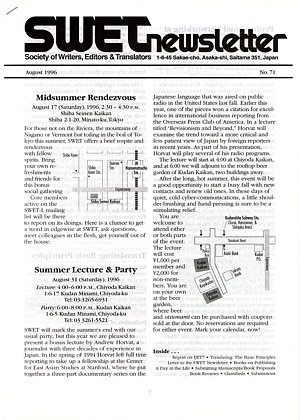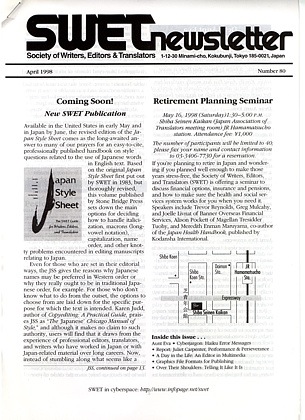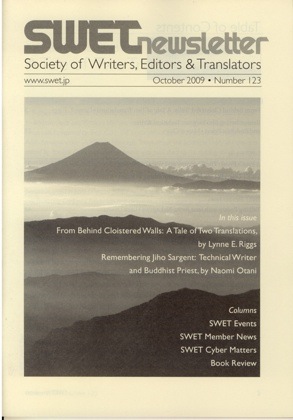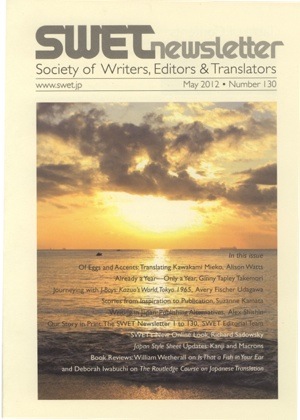May 8, 2012
Our Story in Print: The SWET Newsletter 1 to 130
by Lynne E. Riggs
To mark the publication of the 130th issue of the SWET Newsletter, the last printed issue in its current format, and the transition to new means of information sharing in SWET, members of the Editorial Team contributed to a Q&A about how the Newsletter was made. This exchange adds to the record of an era in SWET’s history and helps readers appreciate the professionalism and sense of mission of the many volunteers and contributors over the years since the first issue was published in 1981.
This issue places a period to the 32-year history of the SWET Newsletter as a periodical in print. Ever since it began to come out in early 1981, the Newsletter has brought news and reports of events, professional advice, tips on technology, and other items of interest to English wordsmiths connected with Japan; and its conception, design, editorial policy, and tone were set by the traditions of print culture. We complete this 130th issue with faith in these traditions: attention to detail, devotion to good writing, consistency in style, care with layout and design. We celebrate the printed page, knowing that it gives a good reading experience and a reliable record.
SWET members have over the past three to four decades met and overcome almost every situation a writer, editor, or translator faces in working with English words in an international publishing environment, and the Newsletter has recorded their experience and wisdom. We hope its pages will not only prove useful to those who continue to work in Japan in coming decades, but also encourage colleagues working elsewhere in the world where English is an adaptable and useful lingua franca.
Translation, especially literary translation, gets a lot of attention lately, but as every translator knows, the actual work of translation involves writing, editing, proofreading, even copywriting, as well, so an organization like ours stands at the convergence of these professions.
Tell us about the first Newsletter.
The Newsletter began in the days of “snail mail”—before email, the Internet, or any sort of online communication. If you wanted to communicate with a group, you needed to put your information on paper, make as many copies as you needed by photocopying, mimeograph, offset printing, or typeset printing; staple the pages; fold them; and mail them out by post. At the very early stages, the layout was done by typing the text in narrow columns on an IBM Selectric typewriter, cutting the paper, and pasting the columns onto A4 layout sheets. Our newsletter logo, created right at the start, gave us an identity. The first volunteers managed with amateur production skills, but one of our more experienced members—editor and book designer Becky Davis—soon took charge and gave us the professional look that SWET has sought to maintain ever since. A handful of other experienced editors coordinated and shaped the Newsletter’s content.
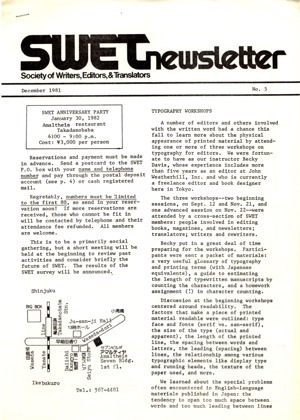 |
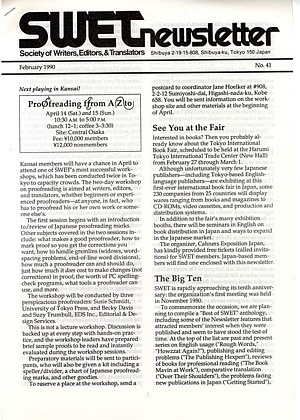 |
No. 5 issue with pages laid out in columns
|
Number 41 issue with pages composed by
|
Some idea of the rich content of the early Newsletter issues can be viewed in the cumulative table of contents available for download as a PDF file (445 KB). Selected articles are available now, and others will be posted online in response to demand. Paper copies of most previous issues are available in the archives of SWET papers upon request.
In addition to writing reports and articles, core volunteers helped with production in the days before DTP software, particularly the paste-up for layout—an exacting task. This was a chance for translators to learn about editorial and design/layout tasks from experts. We learned about how to edit out “widows” (short lines at tops of columns or pages) and “orphans” (short lines at bottoms of paragraphs or pages), how to set headings (twice as much space above as below; not centered), and the fine points of hyphenation, drop caps, and the options for copyediting style.
Soon those with editing and publishing experience became the main coordinators, and the byword for our organization was “professionalism,” both in the look of the finished product and in the way we went about the editing and production processes. Susie Schmidt, then an editor at the University of Tokyo Press, was the anchor and energizer for the editorial process for most of its history until 1996. Schmidt and her cohorts drew countless people into the act, persuading them to write articles, contribute regular columns, review style guides and other reference works, find interesting feature pieces, and send in classified ads. More than 200 writers contributed to the first 100 issues, many quite frequently. Some were long-timers, others were just passing through Japan, and many were young people learning their professions.
The Newsletter carried announcements of upcoming events and maps to the venues, so its publication was often timed with the planning of events. For most of the first two decades, it came out about five times a year. Many of our most pleasant SWET memories were sessions at which volunteers gathered to collate, staple, fold, and stuff the newsletter into envelopes to cart off and mail at the post office. At meetings, social events, and mailing sessions, our then-young children were invariably milling around, helping with their fast fingers or playing boisterously.
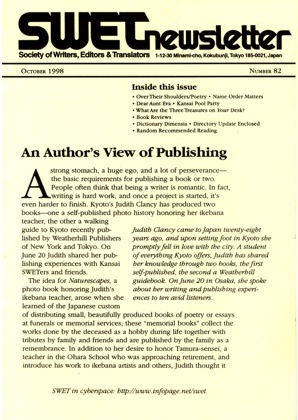 |
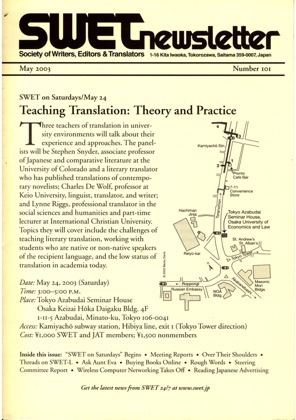 |
No. 82 shows the A5-size design devisedby Ruth McCreery in 1998 |
Number 101 shows the A5 design refinedby Becky Davis in 2003.
|
But maybe what was most memorable about the old A4 newsletter was that it was bursting with the diverse voices of translators, writers, editors, journalists, and others—some members, some not—talking about what they did and recommending good rules and guidelines, resources to rely on, pitfalls to be wary of. There was humor, irony, disdain, and indignation in inspiring doses—as well as plenty of information to help us answer the questions we grappled with in our work.
The Newsletter seems now quite different from what you just described; when did it change and why?
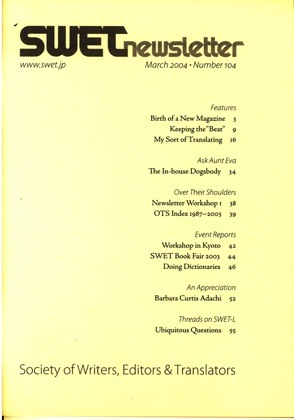 |
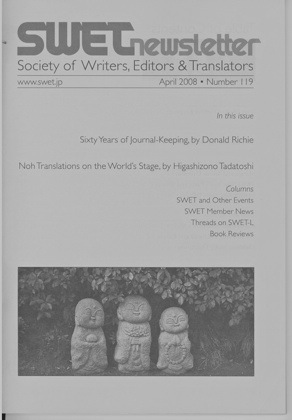 |
No. 104 shows further development of the
|
No. 119 shows further development of the
|
With the raison d’être of the early Newsletter having shifted partly to the website, some argued that its days were numbered. Fewer seemed able and interested in volunteering their time and effort to the publication, and in 2003 the future of the publication was up for grabs.
The time seemed ripe for the Newsletter to evolve into a journal-like publication. The persuasive case for this was made by Lynne E. Riggs, who served as coordinating editor at the time and has continued in that role. One, SWET had become the gathering place for writers, editors, and translators connected with Japan, especially those with literary aspirations who worked in more than one profession. From the beginning, the Newsletter gave these people a voice—in fact, many voices. Their contributions to the organization and to the Newsletter made it a unique publication, and its professional standards made it highly respected. Two, we knew that the established name, reputation, and circulation of a periodical can be a tremendous asset, not just for the interest group of its subscribers, but for the visibility of its niche, and the advancement of the fields or professions it represents. Three, the compilation of finite sets of articles (e.g., features, event reports, how-to items, reviews)—with attractive covers—helps focus energies and aspirations toward a specific goal. Fourth, and maybe best of all, the people who got involved with the Newsletter ended up in a kind of ongoing workshop. We learned from more experienced members and then later passed on what we had learned to newer members.
So these were the ideas that inspired the SWET Newsletter’s reincarnation in 2004. Starting in 1999, SWET was holding nearly monthly meetings, often with extremely interesting panel discussions and speakers. Sometimes preparing write-ups of these events was straightforward, but sometimes it was more complicated, with several editing stages required; through the editorial process, even presentations that might have been a bit disorganized were made coherent and could thereby be shared with our far-flung membership and added to the record of our professions.
The Newsletter thus took wing again as a journal, with long feature articles, detailed reports on events, items on practical skills development, and book reviews. For a while, in an era before going online over breakfast became the norm, flyers announcing events with maps to venues were inserted in the mailings of the Newsletter.
What is the editorial process like? How many drafts does an article usually go through before it is published in the Newsletter?
Each article usually goes through a minimum of three drafts, and sometimes seven or eight in the editorial stage, depending on the state of the initial manuscript and the enthusiasm of the author. When a manuscript comes in—these days always in electronic form—the coordinator first reads it to make sure that it is suitable to our readership, well organized, interesting, not too long, and so on.
The first thing we do is to make sure it has all its “parts”—some authors are in such haste to send off the manuscript that sometimes there is text, but no title or even an author’s name on or in the file! It needs a copyright line, title, author byline, and introductory blurb (which doubles as the annotation about the article on the SWET website). We also start thinking about what images could go with the article and whether permissions will need to be cleared to use them or any of the quoted or translated passages.
Then the article goes to an editor on our “active team” of volunteer editors and copyeditors. For articles written by authors we know or who have been specifically requested to write a piece, copyediting the text according to the SWET Newsletter Style Sheet [link]—available on the SWET website—is the basic chore at this stage, but we also edit the piece and insert comments and queries for improvement or clarification (elaborate on parts, revise certain passages, add sources, check facts, spellings, etc.). Careful preparation of a manuscript from the outset assures that it flows into the layout software with every detail (like macrons, italics, ellipsis points) in place.
Next, the manuscript file goes back to the author, with the various comments and edits to consider and resolve. We generally work in MS Word files, where changes can be shown either with colors, highlighting, and strike-outs or by using Track Changes. The coordinator checks with the author to determine which electronic method of editing suits his/her preference. Not all authors are conversant with the Track Changes or commenting functions of MS Word—indeed, some even refuse to use MS Word!—and we try to accommodate these preferences.
After the file comes back from the author, it is sent to a second editor, who will see it with yet a different editorial eye, and it is also proofread one more time. This final scrutiny of the manuscript is our chance to be sure it is in good shape. Does every word count? Have we been consistent? Do the pages look good and read easily?
Depending on the quantity of changes made in the second edit/proofreading stage, the file may go back to the author again, but if time is limited, it goes straight into the layout stage; the author will have a chance to see it in the galley proof.
When all the manuscripts are at this stage, the files are numbered and organized for the layout and production process. The image files are identified with matching numbers by article and placed in folders for access by the designer. Captions are written for images and inserted into the text files for each article.
Everything goes to the designer at once. Ideally, printouts of all files and images are made and sent to the designer so she can have them on hand for quick reference. Notes about captions, placement of images, and other special features marked on the manuscript facilitate communication between the editor and designer.
The SWET Newsletter’s evolving design could be the subject of a whole article in itself, but we might just add here that it was revamped by our longtime design guru Becky Davis at issue No. 104 and then adapted and revised to its present format in two or three stages by our present designer Anne Bergasse, starting with No. 108.
What has been the most challenging task or aspect of putting the Newsletter together?
Probably it is the writing and the coordinating. A quarterly is a new “book” due out every three months. Occasional and regular contributors are needed, but everything is pro bono—part of our mission to the membership and community. Since we are all “word people,” standards are high: we expect the writing to be good, the design to be readable, the pages to be well proofread and tidy, and the content to be consistently interesting and informative. Organizing events is part and parcel of the momentum of the Newsletter, but every periodical depends on writing. As long as there are people willing to write manuscripts, the content comes together.
Organizing a group of authors and editors toward a common goal three to four months hence—and issue after issue—is likewise difficult. Finding people who can edit, copyedit, and proofread at the various stages of the process, replacing those who cannot for whatever reasons, and guiding people of diverse perspectives and styles in a shared vision of writing and publishing practice calls for patient and flexible management.
SWET is a group in constant flux, with many members coming and going between Japan and their home countries, sometimes shifting to other professions, busy at certain times of year, and so on. As much as we may strive to manage a publication program on a professional schedule, these very human factors come into play. A big part of SWET’s lifeblood is the diversity and flux among the active volunteers—and this is certainly something to embrace and respond to as long as the organization exists.
What are some of the most valuable articles or columns the Newsletter has published?
The archive of SWET is rich for those in our different professions. For example, we often refer editors to the No. 109 write-up of a workshop held in 2005, “Editing in Japan: Three Perspectives,” or to the article “Academic Editing in the Humanities” by Kate Wildman Nakai in No. 112. These are pieces that every editor working in Japan should read. For translators and editors wanting to know how to charge for their work and what units of charge to use, there is “What’s in a Page?” originally published in No. 87. (All these are available to visitors to the SWET website.)
For translators, there is the long-running series “Over Their Shoulders,” presenting translated texts in a variety of genres and offering examples of different styles and choices made by experienced translators. The write-up of the 2003 talk by Edward G. Seidensticker, in No. 104 is a highlight. The series “Translating from Japanese to English,” which began in 2007, now offers more than 10 articles by veteran translators like Janine Beichman, Juliet Winters Carpenter, Rebecca Copeland, Michael Emmerich, and Meredith McKinney. Nearly 100 translation-related articles have been published in the Newsletter, forming a significant body of literature in the field. Few of these articles are currently available online; SWET needs to consider whether to publish a printed anthology. All these articles are available to sustaining SWET members in the PDFs of recent issues in the SWET Newsletter Archive.
For writers, numerous contributions on journalism and writing travel pieces, fiction, and poetry by writers with established reputations. Many of the speakers at SWET events have been writers who made their mark in one genre or another, and their insights are invariably inspiring. Only a fraction of these are available on the website as this time.
We have a great deal of lore about getting along as a professional working with the English word in Japan. Personal stories by members in “How We Got Here” recount their trials and travails as they established their careers; pieces in the “A Day in the Life” series offer tips for managing one’s work. The “Dear Aunt Eva” column, which is online on the website, is a long-running tongue-in-cheek series answering questions about dealing with various kinds of professional situations. The series “Threads on SWET-L” (later “SWET Cyber Matters”) compiled at first by Holly Ueda and later by Torkil Christensen, distills the wisdom of our professional peers shared on the open mailing list over many years from 2001 until 2010. Our series on “Professionalism,” collected together in our 1990 publication Wordcraft, will be available online as well.
Is there any other publication after which the Newsletter is modeled, or that stands in the same category?
Not really. The Newsletter does seem to occupy quite a distinctive niche within the wordcrafting community. The articles are chosen to give our diverse readership as much satisfaction as possible, while recording the activities of the group for the period it covers. You can trace the history of SWET through its pages as well as get a sense of what has been happening in our professions over the years.
What sort of changes can we expect now that the newsletter will be in online form?
Longish articles with substantive content such as those published since 2004 will shift “out” of the SWET Newsletter with this issue. SWET’s efforts to publish news and brief pieces for its members via the website will be focused in the “News” and through the “Columns” sections. “News” will be short items with links to other sites and sources of information. Hopefully numerous members will contribute news of upcoming events or other information of mutual interest. Professional Resources will a place for longer pieces—essays and articles, topical reports deriving from talks and presentations at SWET events, and book reviews—of the type edited and published in issue Nos. 104–130.
The previous editorial team is retiring. Members who are familiar with online publications need to be the core of such a new SWET publishing team, although those who have helped put the old Newsletter together could still be useful in helping establish the content, editorial style, and standards of new electronic publishing endeavors.
Will the kinds of articles published in the Newsletter continue to be published?
Many SWET members are loath to see the old print Newsletter “journal” cease, and if there is sufficient support and authorship, substantive articles might continue to be published in a new “SWET Journal.” Some members have suggested the possibility of editing articles throughout the year and compiling occasional printed anthologies. Hopefully we will continue to provide the means to contribute to the literature of our professions in such a fashion.
Because of the long history of the SWET Newsletter, it is known as a niche periodical for certain kinds of content; it would be a great benefit to the Society and its members to sustain and develop that niche. The work of English wordsmiths connected with Japan—and Asia for that matter—continues to evolve in response to changes in language, views of editing, approaches to translation, needs and trends in publishing and international communication, and technological innovation. As always, there will be endless topics that can be taken up to provide information and insight on our work, help encourage and train a new generation of editors, translators, and writers, and otherwise support our unique community.
This article as prepared by the members of the No. 130 SWET Newsletter Editorial Team (Katherine Heins, Anna Husson, Imoto Chikako, Julie Kuma, Kim Miller, Nina Raj, Lynne E. Riggs, Richard Sadowsky, Susie Schmidt, Ginny Tapley Takemori). Originally published in the SWET Newsletter, No. 130 (May 2012).
© 2012 SWET

